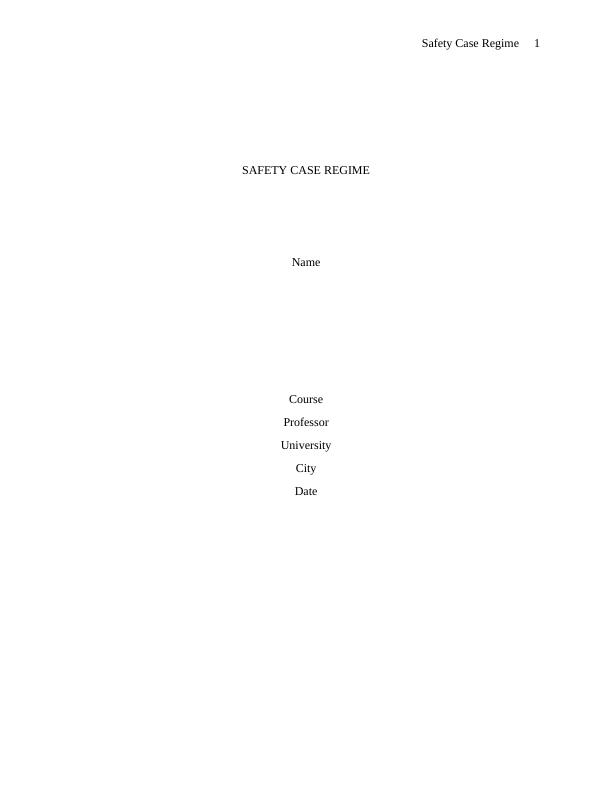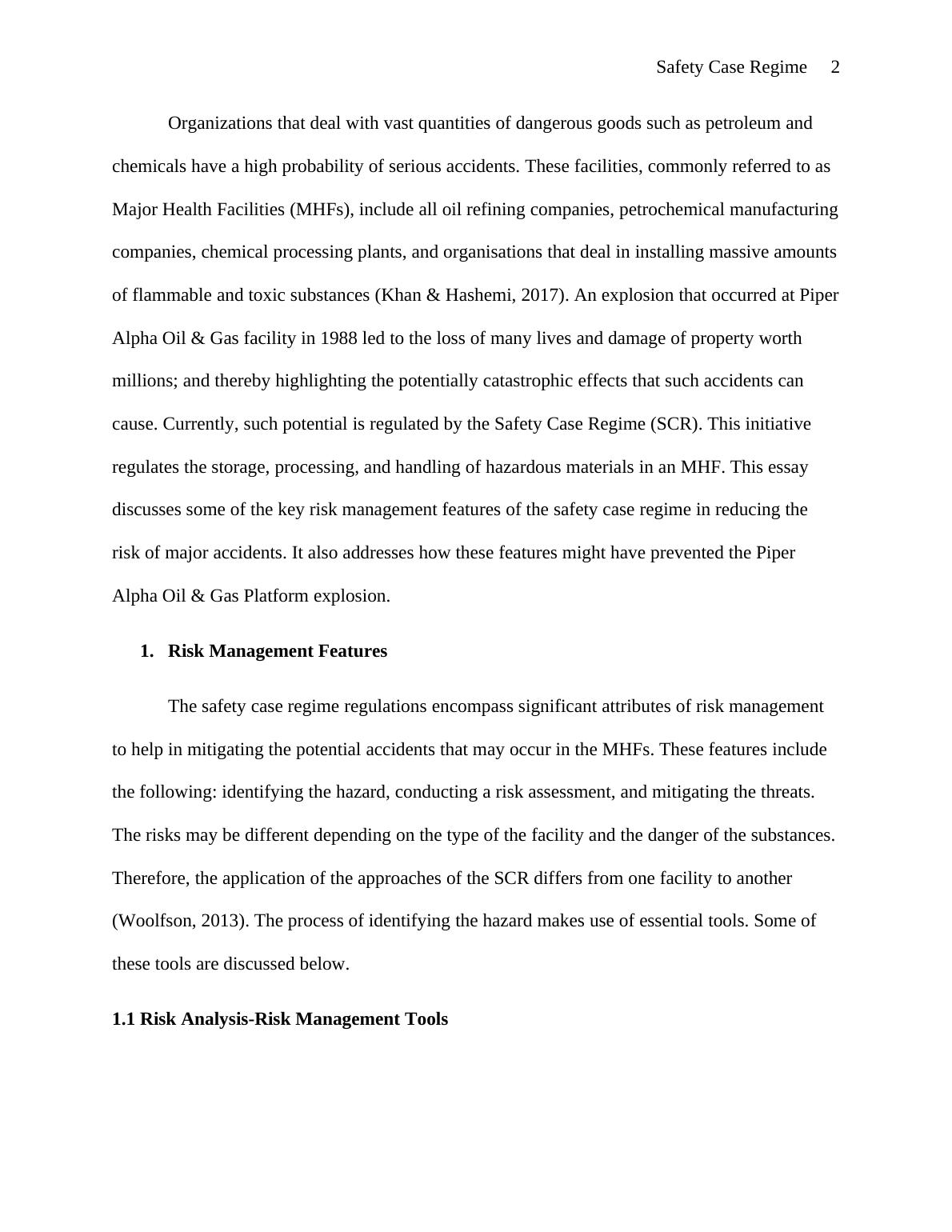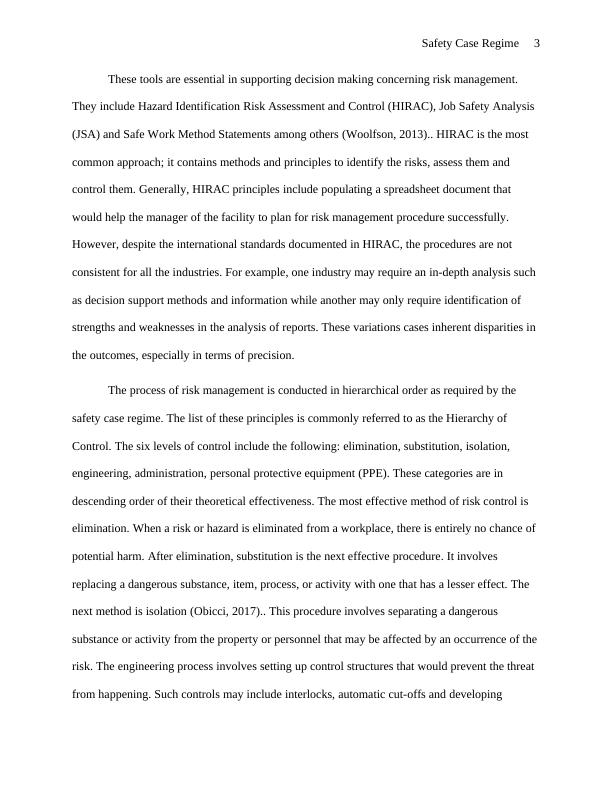Safety Case Regime - Assignment
Added on 2021-05-31
9 Pages2309 Words49 Views
Safety Case Regime 1SAFETY CASE REGIMENameCourse ProfessorUniversityCityDate

Safety Case Regime 2Organizations that deal with vast quantities of dangerous goods such as petroleum and chemicals have a high probability of serious accidents. These facilities, commonly referred to as Major Health Facilities (MHFs), include all oil refining companies, petrochemical manufacturingcompanies, chemical processing plants, and organisations that deal in installing massive amountsof flammable and toxic substances (Khan & Hashemi, 2017). An explosion that occurred at PiperAlpha Oil & Gas facility in 1988 led to the loss of many lives and damage of property worth millions; and thereby highlighting the potentially catastrophic effects that such accidents can cause. Currently, such potential is regulated by the Safety Case Regime (SCR). This initiative regulates the storage, processing, and handling of hazardous materials in an MHF. This essay discusses some of the key risk management features of the safety case regime in reducing the risk of major accidents. It also addresses how these features might have prevented the Piper Alpha Oil & Gas Platform explosion.1.Risk Management FeaturesThe safety case regime regulations encompass significant attributes of risk management to help in mitigating the potential accidents that may occur in the MHFs. These features include the following: identifying the hazard, conducting a risk assessment, and mitigating the threats. The risks may be different depending on the type of the facility and the danger of the substances.Therefore, the application of the approaches of the SCR differs from one facility to another (Woolfson, 2013). The process of identifying the hazard makes use of essential tools. Some of these tools are discussed below.1.1 Risk Analysis-Risk Management Tools

Safety Case Regime 3These tools are essential in supporting decision making concerning risk management. They include Hazard Identification Risk Assessment and Control (HIRAC), Job Safety Analysis (JSA) and Safe Work Method Statements among others (Woolfson, 2013).. HIRAC is the most common approach; it contains methods and principles to identify the risks, assess them and control them. Generally, HIRAC principles include populating a spreadsheet document that would help the manager of the facility to plan for risk management procedure successfully. However, despite the international standards documented in HIRAC, the procedures are not consistent for all the industries. For example, one industry may require an in-depth analysis such as decision support methods and information while another may only require identification of strengths and weaknesses in the analysis of reports. These variations cases inherent disparities in the outcomes, especially in terms of precision.The process of risk management is conducted in hierarchical order as required by the safety case regime. The list of these principles is commonly referred to as the Hierarchy of Control. The six levels of control include the following: elimination, substitution, isolation, engineering, administration, personal protective equipment (PPE). These categories are in descending order of their theoretical effectiveness. The most effective method of risk control is elimination. When a risk or hazard is eliminated from a workplace, there is entirely no chance of potential harm. After elimination, substitution is the next effective procedure. It involves replacing a dangerous substance, item, process, or activity with one that has a lesser effect. The next method is isolation (Obicci, 2017).. This procedure involves separating a dangerous substance or activity from the property or personnel that may be affected by an occurrence of therisk. The engineering process involves setting up control structures that would prevent the threat from happening. Such controls may include interlocks, automatic cut-offs and developing

End of preview
Want to access all the pages? Upload your documents or become a member.
Related Documents
Risk Management: Principles and Features of Safety Case in Offshore Oil and Gas Operationslg...
|11
|2978
|88
FIN4232 - Risk Management - Research Paperlg...
|12
|2916
|34
Risk Management Assignmentlg...
|10
|2742
|74
Safety Case Regime and its role in Risk Managementlg...
|14
|3357
|169
Risk Management Plan - Assignment Samplelg...
|11
|2841
|38
ENG305 Safety , Risk and Reliabilitylg...
|25
|4946
|448
